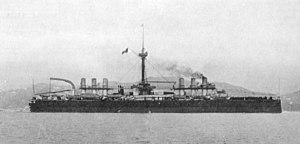Italian ironclad Italia

|
|
| History | |
|---|---|
|
|
|
| Name: | Italia |
| Namesake: | Italy |
| Operator: | Regia Marina |
| Builder: | Regio Cantiere di Castellammare di Stabia |
| Laid down: | 3 January 1876 |
| Launched: | 29 September 1880 |
| Completed: | 16 October 1885 |
| Struck: | 16 November 1921 |
| Fate: | Scrapped, 1921 |
| General characteristics | |
| Class and type: | Italia-class ironclad battleship |
| Displacement: |
|
| Beam: | 22.54 m (74.0 ft) |
| Draft: | 8.75 m (28.7 ft) |
| Installed power: |
|
| Propulsion: | 4 shafts, 4 compound engines |
| Speed: | 17.8 knots (33.0 km/h; 20.5 mph) |
| Range: | ca. 5,000 nautical miles (9,260 km) at 10 knots (19 km/h; 12 mph) |
| Complement: | 669–701 |
| Armament: |
|
| Armor: |
|
Italia was an Italian ironclad battleship build for the Italian Regia Marina (Royal Navy), the lead ship of the Italia class. She and her single sister ship, Lepanto, had lengthy construction times. Italia was laid down in January 1876, launched in September 1880, and completed in October 1885. She was armed with a main battery of four 17 in (432 mm) guns mounted in a central barbette and was capable of a top speed of 17.8 knots (33.0 km/h; 20.5 mph). Unusually, for ships of that era, Italia had an armored deck rather than the typical belt armor.
Italia spent the first two decades of her career in the Active and Reserve Squadrons, where she took part in annual training maneuvers with the rest of the fleet. She was withdrawn from service in 1905 for a significant modernization. Upon returning to service in 1909, Italia was employed as a training ship. During the Italo-Turkish War of 1911–12, the ship provided fire support to Italian troops defending Tripoli in Libya. She was used as a floating battery at Brindisi after Italy entered World War I in 1915. The ship was rebuilt as a grain carrier in December 1917 – June 1918. Italia served in this capacity for only a short time, being stricken in November 1921 and then scrapped.
Italia was 124.7 meters (409 ft) long overall and had a beam of 22.54 m (74.0 ft) and an average draft of 8.75 m (28.7 ft). She displaced 13,678 metric tons (13,462 long tons; 15,077 short tons) normally and up to 15,407 t (15,164 long tons; 16,983 short tons) at full load. Her propulsion system consisted of four compound steam engines each driving a single screw propeller, with steam supplied by eight coal-fired, oval boilers and sixteen fire-tube boilers. Her engines produced a top speed of 17.8 knots (33.0 km/h; 20.5 mph) at 11,986 indicated horsepower (8,938 kW). She could steam for 5,000 nautical miles (9,300 km; 5,800 mi) at a speed of 10 knots (19 km/h; 12 mph). She had a crew of 669–701 officers and men.
...
Wikipedia
